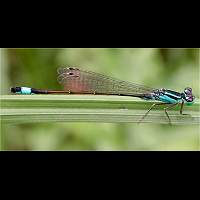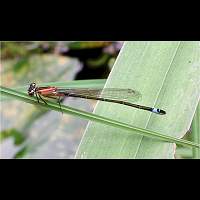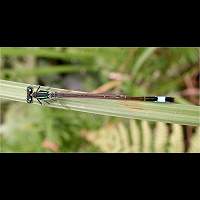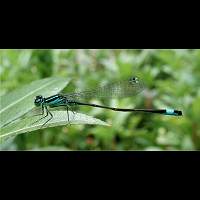[All pictures of garden wildlife on this page are thumbnails. Click on any thumbnail for a large format to be displayed.]
Blue-tailed Damselfly (Ischnura elegans)
The Blue-tailed Damselfly belongs to the group of black and blue damselflies. The animals are very dark on top. Only the 8th segment of the body is entirely blue. In older females this blue may be so dark that you can hardly see it. The Blue-tailed Damselfly does look like some others. It is similar to the Red-eyed Damselflies, but lacks the red eyes of those species. It is also similar to the Scarce Blue-tailed Damselfly, which has part of segment number 8 and the complete segment number 9 blue. In Blue-tailed Damselflies just segment number 8 is blue. On the continent you might encounter the rare Norfolk Damselfly, which is also very similar to the Blue-tailed Damselfly. In the Norfolk Damselfly however, not only segment 8 is blue, but also the starting edge of segment number 9. It is however reported to be extinct in Britain. The lighter parts of the Blue-tailed Damselfly are not always blue. They may be yellow, brown or blue as well. This is partly due to the age and whether the animal has fully reached its colours, but there also appears to be a natural variation in these colourings. Reaching a length of no more than 30 to 35mm and a wingspan of some 40mm, this is one of the smallest damselflies in Britain.
The males usually stay much closer to the water than the females, which may travel long distances. Mating takes several hours and after mating the male looses interest in the females, which will deposit her eggs all by herself. During this process the females may disappear below the water surface entirely. The larvae live in the vegetation, often close to the bank or edge of the water. In Britain it is single brooded, but in southern Europe two or even three generations may appear each year. It is on the wing from May to August.
The Blue-tailed Damselfly is not picky about the kind of water it lives in. Lakes will do, but streams and small ponds too. This is a species appearing in ordinary garden ponds as well, even though it likes some vegetation round the pond. This is probably the most abundant damselfly in Britain. In other parts of Europe, including the northern regions, it is just as common as in Britain.
The males usually stay much closer to the water than the females, which may travel long distances. Mating takes several hours and after mating the male looses interest in the females, which will deposit her eggs all by herself. During this process the females may disappear below the water surface entirely. The larvae live in the vegetation, often close to the bank or edge of the water. In Britain it is single brooded, but in southern Europe two or even three generations may appear each year. It is on the wing from May to August.
The Blue-tailed Damselfly is not picky about the kind of water it lives in. Lakes will do, but streams and small ponds too. This is a species appearing in ordinary garden ponds as well, even though it likes some vegetation round the pond. This is probably the most abundant damselfly in Britain. In other parts of Europe, including the northern regions, it is just as common as in Britain.

© Copyright 1998-2024 gardensafari.net (Hania Berdys)

 English / engels
English / engels  Dutch / nederlands
Dutch / nederlands




